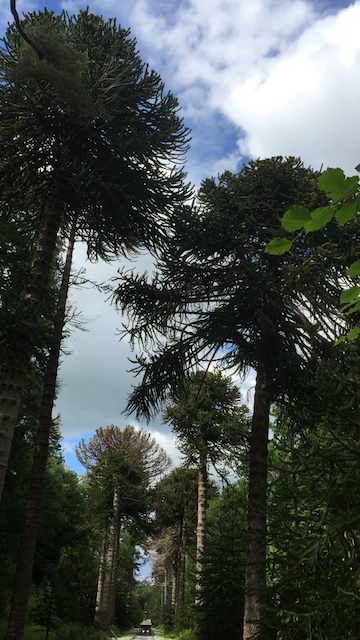The restored Richard Turner glasshouse at Woodstock gardens in Inistioge in County Kilkenny
We recently had visitors staying from England and, because they like walking, old houses and gardens, we decided to take them somewhere special. Woodstock Gardens in Inistioge, County Kilkenny are now being restored by Kilkenny County Council and are a wonderful place for a walk. I’d been before years ago but could only remember the famous Monkey Puzzle avenue, which would’ve been an impressive feature in Victorian times.
The old ruined house at Woodstock. It was built in the years 1745 - 1747 and burned down in 1922
Monkey Puzzle Walk
Unfortunately time had taken its toll on these strange and prickly trees from Chile but a replanting project is underway. The Monkey Puzzle is one of those trees that people seem to either love or hate. We don’t see that many of them these days but, in the 19th century, they were new and exotic. There is actually one that has survived in the garden of the house where I grew up, still upright and tall. I have recollections of running around with my brothers on the lawn in our bare feet and suddenly standing on a fallen prickle… ouch!
The 19th century Monkey Puzzle Walk at Woodstock Gardens which would have impressed Victorians
A quick history of Woodstock House
The house itself is a ruin, with trees growing out of the windows and railings around the base to keep the public away. The mansion was built during 1745 to 1747 for Sir William Fownes and, at the beginning of the 19th century, wings were added on either side. A lot of focus was put on the gardens during the Victorian era, with the Monkey Puzzle walk and the winter garden behind the house being added. There are some other specimen trees that are considered European Champions throughout the grounds.
The magnificent house came to a sad end in 1922. It had been used as a barracks by the Black and Tans, a British regiment, before independence and, during the Civil War, the house was burned down. It is now apparently in a dangerous state of collapse but there are plans to save it from any further deterioration.
The interior and exterior seating areas of the Richard Turner glasshouse tea rooms
Garden renovation
The walled garden is being renovated at Woodstock and I’ll have to go back to see how that turns out. At the moment, there is a long central bed either side of the main path leading from one gate to another but nothing planted there.
There was one spectacular addition since my last visit to Woodstock: The restored Richard Turner glasshouse. When we walked through the walled garden and turned right, it stood before us glinting in the June sunshine, with swathes of blue catmint leading towards its entrance doors. How could we resist having a cup of tea and cake in such splendid surroundings? It was late in the afternoon so we had the place almost to ourselves. (See the video below)
Who was Richard Turner?
Richard Turner was born in Dublin and opened an iron foundry and glasshouse manufacturing business in Ballsbridge in the 19th century. He is considered to be one of the most famous glasshouse designers of his time and created the Palm House at Kew Gardens in London and the beautiful glasshouses in the National Botanic Gardens at Glasnevin in his native city. He also designed a wrought-iron staircase at Woodstock but we couldn’t see this and I’m not sure it still exists.
Woodstock, both the ruin and its gardens, is an inspiring place and one where we can see how important gardens were to old Irish estates. Walking around its leisurely lanes and avenues, time seems to stand still and I could imagine the horses and carriages, the team of gardeners and the family enjoying such beautiful surroundings. Well worth a visit if you’re ever in the area.
VIDEO: Restored Richard Turner glasshouse used as a tea room at Woodstock gardens, Inistioge in Co Kilkenny
Suzanne Winterly is the author of mystery and dual timeline historical mystery novels set in the late 19th century and in the present. More details below:
For more about books, stories and photographs, author research, history and gardening, join Suzanne’s newsletter here:




